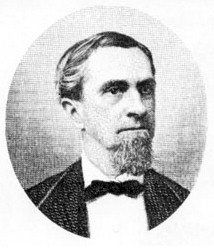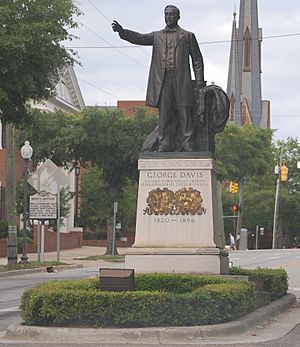George Davis (American politician) facts for kids
Quick facts for kids
George Davis
|
|
|---|---|
 |
|
| 4th Confederate States Attorney General | |
| In office January 2, 1864 – April 26, 1865 |
|
| President | Jefferson Davis |
| Preceded by | Wade Keyes (Acting) |
| Succeeded by | Position Abolished |
| Confederate States Senator from North Carolina |
|
| In office February 18, 1862 – January 2, 1864 |
|
| Preceded by | Constituency established |
| Succeeded by | Edwin Godwin Reade |
| Personal details | |
| Born | March 1, 1820 Wilmington, North Carolina, US |
| Died | February 23, 1896 (aged 75) Wilmington, North Carolina, US |
| Political party | Whig Party (until 1856), Constitutional Union Party (1860) |
| Alma mater | University of North Carolina, Chapel Hill |
| Signature | |
George Davis (born March 1, 1820 – died February 23, 1896) was a politician from the Confederate States of America. He worked as a lawyer for railroads and served as the top legal officer, called the attorney general of the Confederate States, for about 16 months in 1864 and 1865.
Davis was a great speaker. In March 1861, he gave an important speech. He argued that North Carolina should leave the United States. He believed this was necessary to protect the money interests of people who owned enslaved people.
Contents
Biography
Early Life and Career
George Davis was born on a large farm near Wilmington, North Carolina. This farm, called Porters Neck, used the forced labor of enslaved people. He went to the University of North Carolina at Chapel Hill. He was the best student in his class in 1838. After college, he studied law and became a lawyer in 1840.
In 1848, he became the main lawyer for the Wilmington and Weldon Railroad. This was a very good job that paid well. He kept this job for the rest of his life.
Political Beginnings
Davis started his political journey with the Whig Party. This party ended in 1856. Like other Southern politicians, he wanted to avoid a war over slavery. He did not join the Republican or Democratic parties. Instead, he supported the Constitutional Union Party in the 1860 election.
After Abraham Lincoln was elected president, Davis represented North Carolina. He attended the Washington Peace Conference in February 1861. This meeting tried to find a way to avoid war.
Davis was unhappy with ideas that would have kept slavery where it was. But these ideas would have stopped slavery in any new areas of the United States.
When he returned to Wilmington, he believed North Carolina should leave the United States.
Why Secession?
On March 2, 1861, soon after returning from the peace conference, Davis gave a public speech. He spoke about North Carolina's need for "property in slaves."
He clearly stated that he wanted North Carolina to secede. He said leaving the Union was needed to protect the money interests of slave owners. It was also to protect everyone else in the state whose money depended on slavery.
We could never accept the plan adopted by the Convention as consistent with the rights, the interests, or the dignity of North Carolina ... The division must be made on the line of slavery. The state must go with the South.
Leaders in North Carolina who supported slavery decided to leave the Union on May 20, 1861. North Carolina then officially joined the Confederate government. Soon after, Davis was chosen to be a delegate to the Provisional Confederate Congress. Later, he was elected to serve a two-year term in the Confederate Senate.
Confederate Roles
On September 27, 1863, Davis's wife, Mary Adelaide Polk Davis, passed away in Wilmington. She was 43 years old. Her family, the Polk Family, was well-known in politics. Former President Polk was a member of her family. Later that year, William Alexander Graham was elected to the Senate seat Davis held.
To keep George Davis in the struggling Confederate government, President Jefferson Davis (who was not related) appointed him. In January 1864, George Davis became the Attorney General.
George Davis left the Senate and started his new job on January 2, 1864. The Attorney General's job did not involve military matters. Also, the Confederate Supreme Court was never created. So, the Attorney General had little to do. His main tasks were to attend cabinet meetings and write legal advice for other cabinet members. This advice was based on the few Confederate laws. Davis served in this role until he resigned. This happened soon after the Fall of Richmond in April 1865.
He was offered other public jobs before and after the war. But he turned them all down. George Davis never held any public office for the United States of America.
End of the War and Imprisonment
As the Confederacy fell apart, George Davis traveled with the fleeing government. He went as far as Charlotte, North Carolina. He resigned on April 25, 1865, and his resignation was accepted the next day. He had been Attorney General for about 68 weeks.
Davis then tried to escape to England by himself. He planned to go through Florida and Nassau. He chose to leave his children, who had lost their mother, with other family members.
United States forces captured Davis at Key West, Florida, on October 18, 1865. He was held at Fort Hamilton in Brooklyn, New York. He was released on January 2, 1866, by President Johnson.
Later Life
Davis accepted an invitation to be a delegate at the 1866 National Union Convention. This private meeting tried to create a new political party. It aimed to support President Andrew Johnson and his policies. These policies supported white supremacy and tried to undo Congress's plans for Reconstruction.
Davis returned to Wilmington. He started his law practice again and continued to work as a railroad lawyer. Davis married Monimia Fairfax. She was 17 years younger than him. She came from important families in Virginia, the Fairfax and Randolph families.
In 1878, Governor Zebulon Baird Vance offered Davis the job of chief justice for the state supreme court. But Davis turned it down. He said he could not live on the salary.
He gave his last public speech in 1889. It was at a memorial event in Wilmington for Jefferson Davis. In this speech, George Davis summed up his own political career:
My ambition went down with the banner of the South, and, like it, never rose again.
He passed away in 1896 at the age of 75.
Memorials
"Lost Cause" Ideas
After George Davis died, important white leaders in Wilmington and in the state's legal field began to praise him. They presented him as a perfect example of a white Southern man.
Davis had been a Whig who supported the Union at first. He was also a less important figure in the American Civil War. But people who created the false "Lost Cause" story made up a new image of him. They said he was an ideal leader.
For example, in 1915, a writer named Samuel A'Court Ashe gave a speech. He described Davis as a man with no faults or sins. He even praised Davis's handwriting:
Indeed, his very handwriting was an index of that characteristic, every letter being perfectly formed, and his writing without blemish.
Monument
In 1911, a monument to Davis was put up in downtown Wilmington, North Carolina. It was built by the United Daughters of the Confederacy. This was 46 years after the Confederacy lost the war.
The monument showed Davis with his hand on a podium, as if giving a speech. Its stone base had false praise for Davis's supposed good qualities. This was similar to the "Lost Cause" speeches given about him.
Historians say that monuments like this show a big effort by groups like the UDC. Long after the Confederacy failed, they tried to put the false Lost Cause Narrative into people's minds. They also wanted to show non-white people that Reconstruction had failed. And they wanted to support white supremacy.
On June 25, 2020, the statue part of the monument was temporarily removed by the City of Wilmington. This happened around the same time three police officers were fired for "brutally racist" talks. The city said it removed the statue for public safety reasons. The city did not say where it would be stored or when it would be put back up.
On August 2, 2021, the City Council agreed to permanently remove the monument from public land.
Grave Marker
After his death in 1896, George Davis was buried in Wilmington's Oakdale Cemetery. His grave has a flat stone marker with a Celtic cross.
The marker includes a "Lost Cause" message:
Statesman, yet friend to truth of soul sincere
In action faithful and in honor, dear
It also has a changed quote from Psalm 15.
Highway Historical Marker
In 1949, the North Carolina state government put up a historical marker for Davis. It is on US Highway 17 near Wilmington:
GEORGE DAVIS
1820-1896
Served the Confederacy
as a senator, 1862-64, &
as the attorney general,
1864-65. His birthplace
was three miles east.
Liberty Ship
In World War II, the United States liberty ship SS George Davis was named in his honor. A ship named George Davis was built during World War II. It was taken apart for scrap metal in 1960.
Portrait
In 1915, Davis's family gave a portrait of him to the Supreme Court of North Carolina. It hangs in the court's library. All other portraits in the court's collection are of the court's judges.
Sons of Confederate Veterans Unit
A local group of the Sons of Confederate Veterans was named "George Davis Camp 5."


